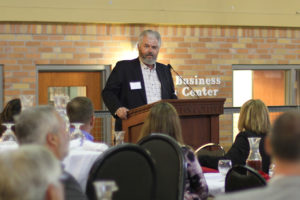On Tuesday, May 22, the Greater Ann Arbor Region (GAAR) hosted a Workforce Opportunity Workshop. This event focused on the talent deficit that our communities are facing today and brainstorming ways to close that talent gap. Presenters included Hillsdale Economic Development Partnership, Ann Arbor SPARK Washtenaw, Ann Arbor SPARK Livingston, Detroit Regional Chamber, The Enterprise Group, Consumers Energy, and Lenawee Now. Each presenter spoke about ways they are solving the talent gap.
Keynote speaker, Mark Alyea, President Emeritus of Alro Steel and Chairman of Governor’s Talent Investment Board (GTIB), spoke about how the talent pool is not necessarily shrinking; the number of qualified people in the talent pool is what is shrinking. Schools need to better prepare their students for the real world by providing students with skills and knowledge needed to apply for jobs, to move through the interview process, and to be prepared for jobs outside of education.
After hearing from the keynote speaker, guests grouped themselves into breakout sessions. The groups reviewed the ideas and discussed how they could incorporate those ideas into their own community. After collaborating during the breakout sessions, the group reconvened as a whole and presented their ideas with further discussion on how to approach the talent crisis as a region.
In closing, Dr. Jeffrey Docking from Adrian College spoke on the next steps in combating the talent crisis. Attendees determined that we need to be looking at the marginalized size of labor pools and identify what types of labor each county needs, so that we can work together to share resources. Lastly, communication needs to be the top priority. Employers need to know what is working well, and we need to know what the students are thinking when they are preparing for graduation and what is to come afterwards.
The GAAR Workforce Opportunity Workshop was a success in bringing the greater Ann Arbor stakeholders together to collaborate on solving the talent crisis as a region. As the regional partners work together to implement the best practices in their own communities, they will continue to collaborate and communicate to make the greater Ann Arbor region the best region in the state for workforce development.

